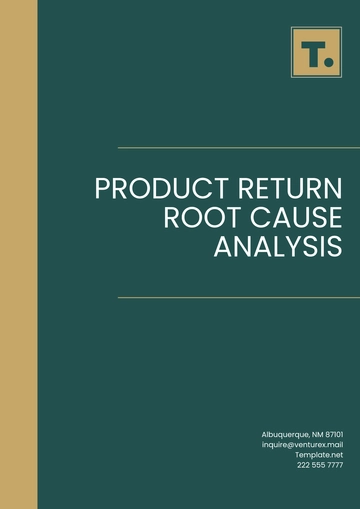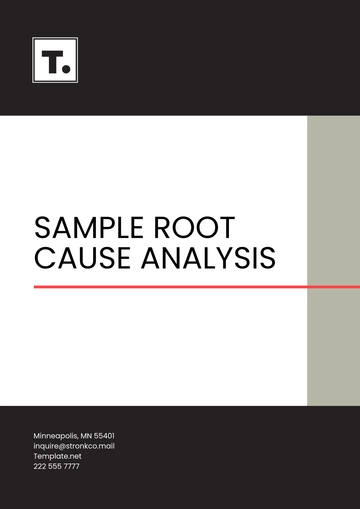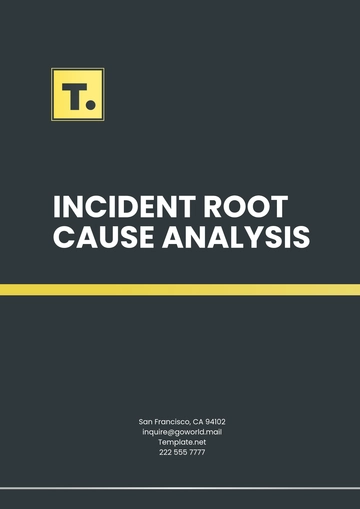Free Professional Business Root Cause Analysis

Prepared By: [YOUR NAME]
Date: January 1, 2060
I. Problem Statement
The recent assessment results indicate a significant decline in learning outcomes across multiple subjects in the organization’s training programs. This decline has been consistent over the past two evaluation cycles, affecting both new hires and existing employees across various departments. Affected areas include comprehension, application, and retention of key material.
II. Cause Identification
To identify the potential causes of the decline in learning outcomes, an in-depth analysis was conducted using the categorization of people, processes, environment, and materials.
A. People
Lack of qualified instructors with industry-relevant experience.
The high turnover rate among training staff affects consistency and quality.
Limited learner engagement due to heterogeneity in trainee motivation levels.
B. Processes
Outdated instructional methodologies not aligned with current learning theories.
Insufficient feedback mechanisms to guide learner improvement.
Inadequate assessment techniques do not accurately measure learning outcomes.
C. Environment
Training facilities are not equipped with modern learning aids and resources.
High levels of distraction in the learning environment impact focus and retention.
Poor coordination of schedules leads to suboptimal attendance.
D. Materials
Obsolete training manuals and resources do not reflect current industry practices.
Insufficient variety of multimedia materials to cater to different learning preferences.
Lack of interactive and hands-on materials fostering experiential learning.
III. Root Cause(s)
After an exhaustive analysis, the root cause of the decline in learning outcomes was determined to be the outdated educational approach compounded by inadequate instructor preparation. The instructional content and methodologies employed have not evolved to match the learners' needs or the industry's demands, resulting in reduced engagement and comprehension.
IV. Corrective Actions
Action | Description | Owner |
|---|---|---|
Instructor Training | Implement a development program to ensure instructors are up-to-date with modern pedagogical methods and industry trends. | Training Department |
Curriculum Update | Revise and update training materials to include contemporary practices and interactive content that engage diverse learning styles. | Curriculum Development Team |
Feedback System | Establish a comprehensive feedback system for continuous improvement based on learner input and outcome evaluations. | Quality Assurance |
Environment Optimization | Upgrade training facilities with necessary technological resources to create an optimal learning environment. | Facilities Management |
V. Evidence/Data
Data collected from training assessments over the past four cycles indicated a consistent downturn in scores, particularly in practical application sections. Interviews with participants revealed dissatisfaction with the pace and style of training. Qualitative feedback highlighted the discrepancy between training material and real-world requirements. Classroom observations documented frequent disruptions and a lack of modern instructional aids.
VI. Timeline
Action | Start Date | End Date | Milestone |
|---|---|---|---|
Instructor Training | January 1, 2060 | March 31, 2060 | Completion of initial instructor workshops |
Curriculum Update | April 1, 2060 | July 31, 2060 | Approval of new curriculum by stakeholders |
Feedback System | August 1, 2060 | September 30, 2060 | Implementation of the feedback tool |
Environment Optimization | October 1, 2060 | December 31, 2060 | Facilities upgrade completion |
First Review | January 15, 2061 | - | Evaluate the impact of changes on learning outcomes |
- 100% Customizable, free editor
- Access 1 Million+ Templates, photo’s & graphics
- Download or share as a template
- Click and replace photos, graphics, text, backgrounds
- Resize, crop, AI write & more
- Access advanced editor
Streamline your business problem-solving with the Professional Business Root Cause Analysis Template from Template.net. Designed to identify and address critical issues, this template is fully editable and customizable to suit your needs. Utilize its structured layout to organize findings and implement effective solutions seamlessly. The template is editable in our Ai Editor Tool, ensuring quick and effortless modifications tailored to your requirements.





























